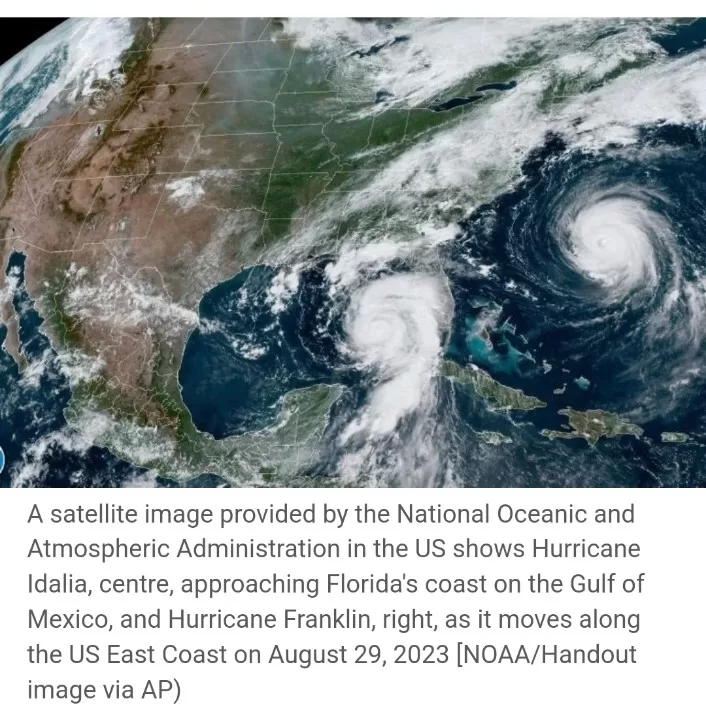A cataclysmic turn of events unfolded as Hurricane Idalia, a menacing Category 3 storm, made landfall in Florida’s Big Bend area, thrusting millions of American citizens into a frantic state of evacuation or lockdown in anticipation of an impending life-threatening tidal surge. Drawing its ferocity from the warm embrace of the Gulf of Mexico’s heated waters, Idalia released its wrath in the form of annihilating winds and deluges of rain, poised to induce coastal inundation of depths reaching an astounding 16 feet along the Gulf Coast.
Idalia’s incursion commenced at 7:45 am EDT (1145 GMT) in Keaton Beach, a tranquil coastal enclave housing 13,000 residents in Taylor County, situated about 75 miles southeast of Tallahassee, the state capital. Nestled within the heart of the Big Bend territory, where Florida’s northern panhandle gracefully curves into the peninsula, this town became the epicenter of the storm’s impact.
With an ominous ferocity, Idalia marauded through Taylor County, leaving County Commissioner Jamie English to report, “It’s just ripping through Taylor County now. Hope all is safe. Winds gusting. Terrible power outages all over. Debris flying everywhere.” As the tempestuous tempest roared, scant information about flooding emerged. As midmorning dawned, a National Oceanic and Atmospheric Administration weather station located in Steinhatchee, positioned 20 miles south of Keaton, recorded water levels surging to 8 feet, surpassing the 6-foot flood threshold. Further south in the densely inhabited Tampa region, monitoring stations registered water levels at a stage categorized as “minor flooding” by 10 am EST.
Throughout the night, the residence of Mark Feinman’s in-laws in St. Petersburg bore the brunt of roaring winds and ceaseless sheets of rain. Evacuating alongside nine individuals and two feline companions, Feinman, a 37-year-old professional drummer and songwriter, abided by evacuation directives to reach higher ground. Although he expressed the desire to check on his parents, who resided merely a mile away, he affirmed that damage assessments would have to wait until the tempest subsided. “Currently, the atmosphere is more serene,” he conveyed during a telephone exchange. “As of now, we have been spared from flooding. Hopefully, we have managed to evade the worst of the storm.”
The tempest, having briefly achieved an “extremely dangerous Category 4 intensity” during the night on the Saffir-Simpson wind scale, demonstrated a marginally diminished force, transitioning to a Category 3 tempest with maximum sustained winds of 125 miles per hour by 7 am EDT, as reported by the National Hurricane Centre (NHC) headquartered in Miami. By 9 am EDT, these winds ebbed further to 110 mph, corresponding to the pinnacle strength of a Category 2 storm, according to the NHC.
As the sun emerged on the horizon, the residence of Ken Wood in Dunedin, located near Tampa and approximately 185 miles south of the landfall site, was besieged by the gusts of the storm. Despite being a bridge tender in Pinellas County, Wood chose not to heed evacuation orders, confident that his location was sufficiently elevated. “Currently, it’s a cacophony of forceful wind and torrential rain, accompanied by sporadic thunder,” he communicated via telephone. Wood noted that roads were submerged due to flooding and that the sky bore a somber hue.
Peril Looms Large
A vast majority of Florida’s 21 million inhabitants, along with residents in the adjoining states of Georgia and South Carolina, were subjected to hurricane advisories and warnings. State governments in all three states declared states of emergency in response to the impending tempest.
Florida’s Gulf Coast, southeastern regions of Georgia, and the eastern expanse of North and South Carolina are anticipated to encounter rainfall ranging from four to eight inches through Thursday. Some regions might experience localized downpours of up to a foot, as cautioned by the hurricane centre.
The most alarming facet of the storm is expected to be an overpowering surge of wind-propelled waves poised to inundate coastal lowlands. Surge alerts spanned hundreds of miles of coastline, from Sarasota to the western edge of Apalachicola Bay. Projections indicated that in select areas, the surge could surge to an astounding 16 feet, as conveyed by the NHC.
Florida Governor Ron DeSantis, who is a Republican presidential nomination contender for the 2024 elections, remained in constant communication with US President Biden regarding the storm’s impending onslaught. The president addressed the government’s efforts in response to the hurricane.
Deanne Criswell, administrator of the US Federal Emergency Management Agency (FEMA), disclosed that over 1,000 personnel from FEMA’s rapid assessment teams were poised for immediate deployment to evaluate storm-related damage once Idalia subsided. Criswell also extended a cautionary note to residents in neighboring states, Georgia and South Carolina, emphasizing preparedness and vigilance.
“Only time will unveil the extent of the devastation, and there is the potential for further occurrences,” she remarked, alluding to the ongoing active hurricane season.
Having burgeoned from a tropical storm into a hurricane subsequent to skirting the western side of Cuba, where it wrought destruction on homes, provoked power outages, submerged villages, and compelled mass evacuations, Idalia marks the fourth major hurricane to strike Florida within the last seven years. The lineage includes Irma in 2017, Michael in 2018, and the Category 5 force of Ian in September of the prior year.




